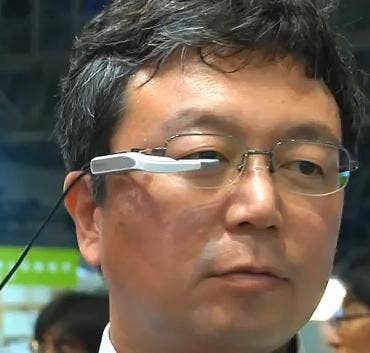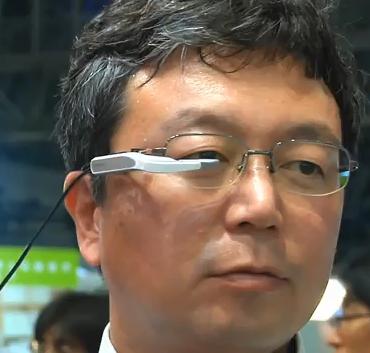Augmented Reality On Your Glasses, Maps in Your Eyes (video)

Share
How do you know you're watching a science fiction movie? Easy - there's always someone who has a video, or message, or digital map, that appears directly on their glasses. Futuristic specs are such a scifi trope that it really was no surprise when Japanese mobile giant NTT DoCoMo unveiled an augmented reality mapping system that attaches directly to your lenses. AR Walker uses a gyroscopic sensor to determine which direction your head is facing and relays pertinent information to you through a tiny display screen in front of your right eye. Look up and get a weather report, look left and right to get info about restaurants and shops, look ahead to get directions to where you want to go. The augmented reality device is powered via a smart phone with GPS that hangs around your neck. The commercialization for AR Walker is likely many years away, but that didn't stop it from drawing a big crowd when it was on display at CEATEC this year. Check out the future of eyewear in the video below. It looks pretty cool, but where is the radar system that lets me see the monster aliens I'm trying to fry with my laser gun?
I've only had a smart phone for less than a year, but it's remarkable how much I rely upon it for directions and suggestions. There's probably not a day that goes by that I'm not checking a Google map for the best time to catch a bus, or a Yelp map to see what restaurants are nearby when I'm in a new neighborhood. (As for weather...meh, I live in San Francisco, weather's not something you look forward to learning more about.) What I'm trying to get at is that the AR Walker is a great concept because it takes all the information we want from our smart mobile devices and puts them directly where we can see it. No need to open the phone and fidget with Apps, just look around you and see the data you need.
This next video, from the guys at Engadget, isn't that informative unless you speak Japanese. It does, however, show you what the AR Walker screen actually looks like, starting around 4:08.
Be Part of the Future
Sign up to receive top stories about groundbreaking technologies and visionary thinkers from SingularityHub.


For those of you who already use augmented reality maps for your smart phones (I can't say enough good things about the Layar catalog) the AR Walker may not appear all that thrilling. These Applications can take the video feed from your mobile phone camera and superimpose images/icons that give you data about restaurants, directions, weather, etc. Of course, you have to be looking at your phone while you do this, and it's not easy to walk around with a smart phone in front of your face and look cool. Or avoid traffic, for that matter. The real advantage that the AR Walker has over current technology, then, is that it's sitting on your glasses. Working with its partner, Olympus, NTT DoCoMo could develop this eye-level screen and bring it to market soon.
Could, but won't. NTT DoCoMo has made it clear that the AR Walker is just a prototype, and there aren't any upcoming commercialization plans. We have the technology (it's really just a smart phone hooked up to a tiny video screen), but we haven't developed it enough to make this device very appealing. Yes, in the moment you want information it's better to have the data already at eye level rather than having to pull out your phone. The rest of the time, however, wearing a clip-on viewer on your face is going to be distracting, and probably a bit uncomfortable.
The setup needs to be miniaturized and streamlined so that you can wear it all day and never know it was there. You need to be able to customize controls, and adapt them to different situations - you don't always want to see weather reports just because your head is tilted up. Ideally, you wouldn't connect the eye piece to a smart phone, you'd want the eye piece to be the smart phone. I think the screen would work best as part of a complete augmented reality personal interface system with cameras and gesture controls, like the SixthSense device created by Pranav Mistry. It's going to take years, probably quite a few, before any company can develop an augmented reality eye piece that is going to sell well in the global market. But when they do I'll probably become as addicted to it as I have to my smart phone.
Where's that damn ATM, I can't find it on my phone's map! Oh, I'm standing in front of it? Heh, silly me.
[screen capture credit: Nick Barber (Network World/IDG News)]
[video credit: Nick Barber (Network World/IDG News), Engadget]
[sources: Computer World/IDG News]
Related Articles

How Scientists Are Growing Computers From Human Brain Cells—and Why They Want to Keep Doing It

These Brain Implants Are Smaller Than Cells and Can Be Injected Into Veins

This Wireless Brain Implant Is Smaller Than a Grain of Salt
What we’re reading
